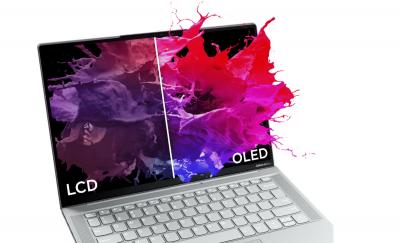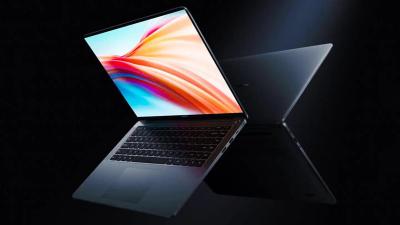OLED (Organic Light Emitting Diode) is a display technology that is brighter, more efficient, thinner and feature better refresh rates and contrast than an LCD display. OLEDs deliver the best picture quality ever and OLED displays have been used in smartphones, wearables and TVs.

Why are OLED displays better than LCDs?
- In OLED displays, each pixel emits light independently (in LCDs, there is a white backlight).
- The contrast ratio of OLEDs is much better than in LCD, so are the refresh rates and the viewing angles.
- OLEDs are thinner and lighter than LCDs, and can be made flexible, foldable, rollable and transparent.
- OLEDs are more efficient, as only lit pixels draw energy. A smart user interface can result in very power efficient OLED displays!
One of the major drawbacks of an OLED display is that because each pixel is driven independently and because the lifetime of an OLED emitter is limited, OLED panels suffer from image retention (known as burn-in). A much-used pixel is less bright than a pixel that hasn't been driven a lot (for a more technical explanation, click here). In computer user interface this is a problem - as some UI elements are quite fixed (toolbars, icons, etc). There are some technologies to handle this problem - for example by measurement and compensation, by using a tandem architecture to extend lifetime, and more. As there are millions of laptops sold annually with OLED displays, it seems as the industry has pretty much solved the burn-in problem.
OLED laptops today
OLEDs are already very successful in smartphone displays (where almost a billion panels are produced annually), OLED TVs and wearables. For some years now we are seeing an increased adoption of OLED displays in laptops, as companies such as Lenovo, Dell, HP, Samsung, Xiaomi and others adopt high-end AMOLED displays in their high-end and mid-range laptops. Click here for our complete list of laptops with OLED displays.

Further reading
Omdia: shipments of OLEDs over 9-inch in size will soar 124% in 2024
According to Omdia, sales of OLED panels in sizes over 9-inch (the company refers to these as Large Area Displays) will increase 124.6% in 2024. In 2023, the market contracted 25.7%, with the only exception being OLED monitor panels that grew in shipments.
In 2024, Omdia says that all application areas will see an increase in shipments - TVs, monitors, tablets and laptops. Only the company's "other" category will see a decrease in sales. In particular, tablet OLED shipments are projected to increase by 294% compared to 2023, largely due to Apple's adoption of OLEDs in the 2024 iPad Pro tablets. Laptop OLED sales will increase 152.6%, and monitors OLEDs will increase 139.9%. Finally, OLED TV panel shipments will increase 34.8%.
DSCC: demand for AMOLEDs to increase, but the market will remain in oversupply
DSCC says that the AMOLED industry (mainly smartphones and IT applications) is still in oversupply, and this will remain so until 2028 - but demand is expected to increase faster than capacity and so the oversupply will gradually decline to 2028.
Regarding OLED TVs, demand will increase and fab utilization will improve - but in this market DSCC also sees an oversupply situation to 2028 at least (a surplus of 22% in 2028).
LG Display starts mass producing 13-inch tandem laptop OLED panels
LG Display says that it has started to mass produce tandem OLED laptop panels, the first company to do so. LGD says its tandem architecture double the lifetime of its OLEDs, reduce power consumption by up to 40%, and enable up to three times the brightness.
LGD has been producing tandem OLED displays since 2019, mainly for the automotive industry. This expertise has enabled it to be Apple's main tandem OLED display suppler for its 2024 iPad Pro devices, and now to be the first one to produce tandem laptop panels.
DNP starts producing 8-Gen FMM masks at its new $140 million Kuosaki plant
Dai Nippon Printing (DNP) announced that it has started mass producing fine metal masks (FMM) at its new production line at Kurosaki Plant, in Fukuoka, Japan. DNP invested $140 million to expand the production line.
8-Gen and 6-Gen FMM samples (DNP)
The new production line is producing masks suitable for 8-Gen substrates. As the OLED industry is moving to expand its IT AMOLED display production for laptops, monitors and tablets, companies are building larger (8.7-Gen mostly) production lines that require these larger masks. While the company is already producing at the new fab, it will also announced that it may gradually expand production further at the new line, depending on market demand.
LG to supply 100,000 13" tandem laptop OLED panels to Dell
According to a report from Korea, LG Display has started to produce 13.4" tandem AMOLED panels for Dell, to be used in the upcoming 2024 XPS 13 laptop. LGD will produce 100,000 such panels for Dell at its E6 production line (the same line used to produce Apple's iPad Pro displays).
The tandem OLED displays will enable longer lifetimes, and also increased brightness / efficiency. Interestingly, Dell says the displays will only feature a brightness of 400 nits. The full display specification: 13.4" 3K+ (2880x1800) 60Hz 400 nits AMOLED panels.
Visionox announces plans to build a $7.6 billion 8.6-Gen AMOLED line in Hefei
Visionox is the latest company to announce a new AMOLED production line, targeting the IT display market - laptops, monitors and tablets. The company said that it will best 55 billion Yuan (around $7.6 billion USD) to build a 8.6-Gen production line in Hefei, Anhui province.
Visionox's production line will have a monthly capacity of 32,000 substrates. The company did not share any details regarding the timeline of this project, or its financing.
TCL CSOT shows its latest OLED, MicroLED and QD-EL displays at Displayweek 2024
TCL CSOT demonstrated its latest displays, technologies and prototypes at Display Week 2024. The company is focused on inkjet printing technologies, and a lot of the displays on show were indeed printed.
So first up, we TCL demonstrated a 14" 2880x1800 400 nits 30-120Hz ink-jet printed LTPO AMOLED display. The display is produced on a glass substrate, with thin film encapsulation (a 'hybrid OLED').
BOE shows new OLED displays at SID Displayweek 2024
BOE had a large demonstration at Displayweek 2024, showing several display technologies and many new panels and prototypes.
First up we have a slidable OLED display, one of the largest we've seen, at 31.6". The display offers a resolution of 5944x1672, a sliding distance of just over 260 mm (BOE says its the world's longest) and a sliding radius of 5 mm.
Omdia: sales OLED tablet and laptop to reach 99 million units in 2031
Omdia estimates that OLED display shipments for laptops and tablets will grow from around 8 million units in 2023 to around 99 million units in 2031, a CAGR of 37%. We have already seen major laptop and tablet brands starting to adopt OLEDs in their latest devices, including Apple and Microsoft just recently.
Omdia says that in 2022 and 2023, the demand for laptops and tablets actually slowed, but new laptops with AI capabilities are now being introduced, and Omdia expects a recovery in demand for mobile PCs following the discontinuation of Windows 10 support in the second half of 2025.
Samsung shows its latest OLED and QD-EL displays at Displayweek 2024
Samsung Display had a rather large booth at Displayweek 2024, showing its latest OLED displays and technologies. Samsung showed several displays - including foldable smartphone panels, laptop and tablet displays, two QD-OLED displays, its 9.4" round automotive AMOLED, and more.
One interesting display was a panel that combines a foldable and a rollable display, that can open up to an impressively large display. Samsung brands it as a Flex Note Extendable Display.
Pagination
- Page 1
- Next page







